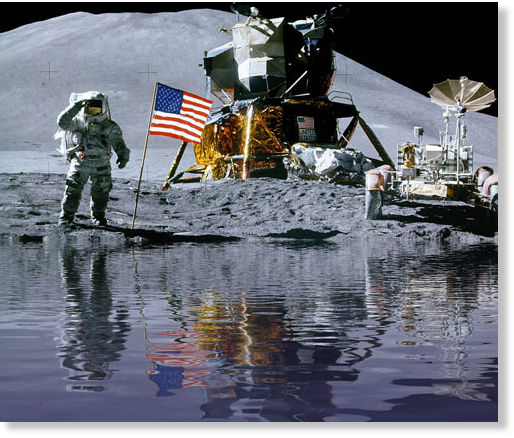February 23, 2023
More Than a Bucketful
Originally published April 1, 2013

image from Larry Taylor*
Soon after LCROSS smashed into Cabaeus crater near the South Pole, the science team jubilantly announced that bucketfuls of water were released from the crater. Since then there have been discoveries of hydroxyl or water across many parts of the lunar surface, and more reports accumulate that water is trapped in lunar magmas from the time of their formation. The Moon is wetter than anyone thought. Perhaps then it was no surprise when Prof. Julius Kelp of Wellman College announced that the hyper resolution NAC images, and the Diviner and Moon Mineralogy Mapper Cubed spectrometers detected incontrovertible evidence that the lunar maria are actually sediment deposits. NAC images privately shown to a few scientists at the Lunar and Planetary Science Conference in Houston two weeks ago revealed that sinuous rilles were the sources of voluminous flows of water that brought up sand-sized bits of mafic rocks from the mantle and distributed them as sediments across the deep basin floors. The spectral data determined that the famous red spots were actually rust, demonstrating that water and oxygen were formerly abundant on the Moon. The long wavelength Diviner data were critical in determining that the Reiner Gamma swirl is a deposit of salt, enriched in magnetite, that faithfully maps out the confused lunar magnetic field. The idea that the Moon ever held significant amounts of surface water appears absurd because its gravity is too low and its temperature too high to prevent rapid Jeans escape to space. However, Dr. Kelp proposes that the Moon was formerly in locked rotation with the Sun so that one, very hot, side always faced the Sun and the other cool side didn’t. Any water brought to the surface on the hot side either evaporated and escaped or migrated to the cool side, where Earthshine kept it warm enough to not freeze. And of course, water eruptions on the cool size filled the basins and persisted for a few hundred million years. That is why so few craters exist on the mare – impacts simply created splashes, some of which sculpted the enigmatic ghost craters. The present farside was the hot side and the present nearside was the coolside, nicely solving the mystery of why the maria are nearly all on the nearside even though there are basins on both sides. NASA and Golden Spike have accelerated their programs to return to the Moon, and one astronaut training in the neutral buoyance tank was overheard to wonder if he should take his fishing pole.
Chuck Wood
- (Who is innocent of any association with the text)
Related Links
Lunar Rivers. Lingenfelter, R.E., S.J. Peale & G. Schubert (1968) Science 161, 266.
Distribution of Sinuous Rilles and Water on the Moon. Peale, S.J, G. Schubert & R.E. Lingenfelter (1968) Nature 220, 1222.
Evidence for the Pristine Presence of a Lunar Hydrosphere. Gilvarry, J.J. (1964) Publications of the Astronomical Society of the Pacific 76, No. 451, p.245.
Yesterday's LPOD: Happy Spring
Tomorrow's LPOD: Treasure Hunting
COMMENTS?
Register, Log in, and join in the comments.



